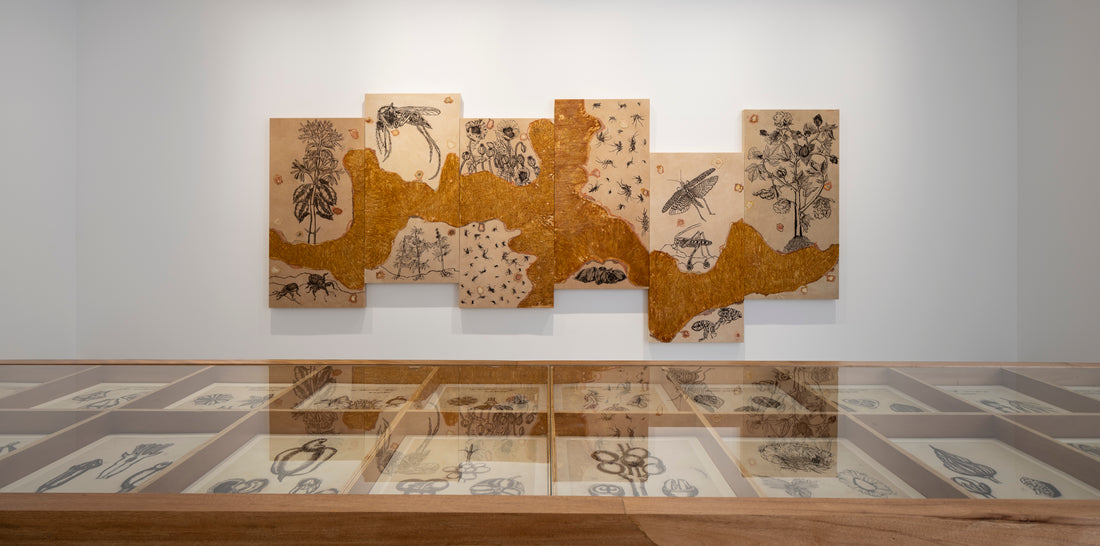
Lavanya Mani: harnessing kalamkari, embroidery, tie and dye, appliqué and batik
Guest edited by Mira Gupta
Art and craft are two sides of the same creative coin, yet with distinct shades. Both involve skill, imagination, and the desire to express, but are perceived differently.
Art seeks to evoke emotion, challenge thought, and spark conversation. A painting might not be functional, but its brushstrokes can ignite contemplation on societal issues. Craft, grounded in practicality, emphasises the creation of beautiful and useful objects. It aims to marry artistry with functionality, resulting in objects that enhance everyday life. A hand-stitched quilt, though imbued with aesthetic beauty, also provides warmth and comfort.

However, the lines between these two worlds are not always clear. Art often draws inspiration from the techniques and traditions of craft, weaving them into its tapestry of expression. Many contemporary artists, from Ai Weiwei to Grayson Perry, draw heavily on craft techniques and traditions, challenging the rigidity of the categories.
Lavanya Mani, the Vadodara-based artist, harnesses traditional Indian craft techniques of Kalamkari, embroidery, tie and dye, appliqué and batik in conjunction with painting on cloth. While studying creative painting at the Faculty of Fine Arts, MSU Vadodara, she was encouraged to look at what is usually considered "women's work" in a more artful context. In this endeavour, she is part of a long tradition of women artists who have challenged the notion of craft as somehow inferior to painting and sculpture.

Kalamkari is a gruelling technique: involving more than twenty steps, and the knowledge is passed on within families. Mani was not from a Kalamkari family and had to learn the craft from scratch. She was fascinated too by the colonial implications of the textile trade from India, which effectively resulted in India losing her independence, and the broader issues of imperialism and political domination. These are the themes she explores in her works, combined with references to Indian miniature painting and Victorian literature.
Here is how she describes her work, "I have also been particularly interested in correspondences between 'textiles' and 'text' and metaphors relating the two such as– 'to spin a yarn', 'to follow a thread of narrative', 'to embroider a tale', 'to weave a tale', 'to fabricate', and their link to the construction or the making of 'history', especially true in the context of 'discovering' the East."

Mani's works are truly a great example of how art, in its transformative embrace, elevates craft from utilitarian purpose to aesthetic wonder, proving that beauty often blooms from the seeds of practical skill. To sever the thread binding art and craft is to unravel the tapestry of human expression, for each relies on the other's strength to weave stories that resonate across time.
On Saturday 8 June 2024 at 14:00 BST, we will be holding an Online Symposium inspired by issue 117: Irresistible of Selvedge Magazine inviting a discussion around the irresistible nature of resist-dyeing techniques around the world. Join us to discuss batik and its history and legacy. Book your tickets now: www.selvedge.org/products/-online-symposium-irresistible
Art and craft are two sides of the same creative coin, yet with distinct shades. Both involve skill, imagination, and the desire to express, but are perceived differently.
Art seeks to evoke emotion, challenge thought, and spark conversation. A painting might not be functional, but its brushstrokes can ignite contemplation on societal issues. Craft, grounded in practicality, emphasises the creation of beautiful and useful objects. It aims to marry artistry with functionality, resulting in objects that enhance everyday life. A hand-stitched quilt, though imbued with aesthetic beauty, also provides warmth and comfort.

However, the lines between these two worlds are not always clear. Art often draws inspiration from the techniques and traditions of craft, weaving them into its tapestry of expression. Many contemporary artists, from Ai Weiwei to Grayson Perry, draw heavily on craft techniques and traditions, challenging the rigidity of the categories.
Lavanya Mani, the Vadodara-based artist, harnesses traditional Indian craft techniques of Kalamkari, embroidery, tie and dye, appliqué and batik in conjunction with painting on cloth. While studying creative painting at the Faculty of Fine Arts, MSU Vadodara, she was encouraged to look at what is usually considered "women's work" in a more artful context. In this endeavour, she is part of a long tradition of women artists who have challenged the notion of craft as somehow inferior to painting and sculpture.

Kalamkari is a gruelling technique: involving more than twenty steps, and the knowledge is passed on within families. Mani was not from a Kalamkari family and had to learn the craft from scratch. She was fascinated too by the colonial implications of the textile trade from India, which effectively resulted in India losing her independence, and the broader issues of imperialism and political domination. These are the themes she explores in her works, combined with references to Indian miniature painting and Victorian literature.
Here is how she describes her work, "I have also been particularly interested in correspondences between 'textiles' and 'text' and metaphors relating the two such as– 'to spin a yarn', 'to follow a thread of narrative', 'to embroider a tale', 'to weave a tale', 'to fabricate', and their link to the construction or the making of 'history', especially true in the context of 'discovering' the East."

Mani's works are truly a great example of how art, in its transformative embrace, elevates craft from utilitarian purpose to aesthetic wonder, proving that beauty often blooms from the seeds of practical skill. To sever the thread binding art and craft is to unravel the tapestry of human expression, for each relies on the other's strength to weave stories that resonate across time.
On Saturday 8 June 2024 at 14:00 BST, we will be holding an Online Symposium inspired by issue 117: Irresistible of Selvedge Magazine inviting a discussion around the irresistible nature of resist-dyeing techniques around the world. Join us to discuss batik and its history and legacy. Book your tickets now: www.selvedge.org/products/-online-symposium-irresistible

1 comment
Incredible work brilliantly presented by Mira Gupta